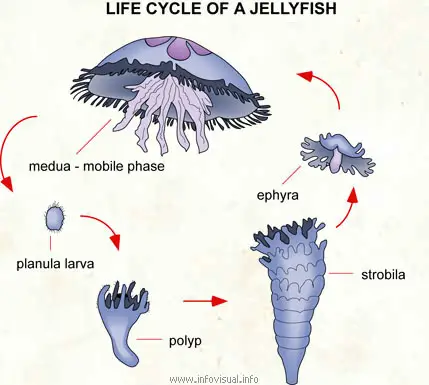Life functions and Motile form
This phylum contains a vast amount of jellyfish, with their squishy bodies and colorful souls. They also contain hydra, sea anemones, and corals. Their tissues are very organized, and some similar cells go together in groups that are actually called tissue, but no true organs occur. Sometimes their bodies have two, or even three layers. The gastrovascular cavity, or others may call it the coelenteron, has an opening that both serves as mouth and anus. They have two simple body forms, medusa and polyp. Medusa, are adult jellyfish floating and moving around, they have umbrella like shaped bodies and tetramerous, a four part symmetry. Polyp are often sessile, they have tube like bodies and one end is attached to substrate and a mouth. Sometimes they are alone, or in groups and different individuals can have different functions. The Polyps are asexual and reproduce by budding. Medusa use sexual formation of gametes, and even some polyps do this as well. Some of them may be monoecious or dioecious.
Reproduction
Sexual reproduction can result in planula larva, witch means it is ciliated and free swimming. The life cycle of a jelly fish goes, larva, polyp, strobila, ephrya, medua. The last stage being its mobile stage.
Ecological role
Their role in the ecosystem is to keep balance in the food chain. Other fish eat them, and some even ride them. Some fish even use them as homes.
Interesting fact
They are very interesting creatures, they are mostly composed of water, more then 95% and have no brain, heart or bones or no actual eyes.
Reference: http://animaldiversity.ummz.umich.edu/site/accounts/pictures/Cnidaria.html





No comments:
Post a Comment